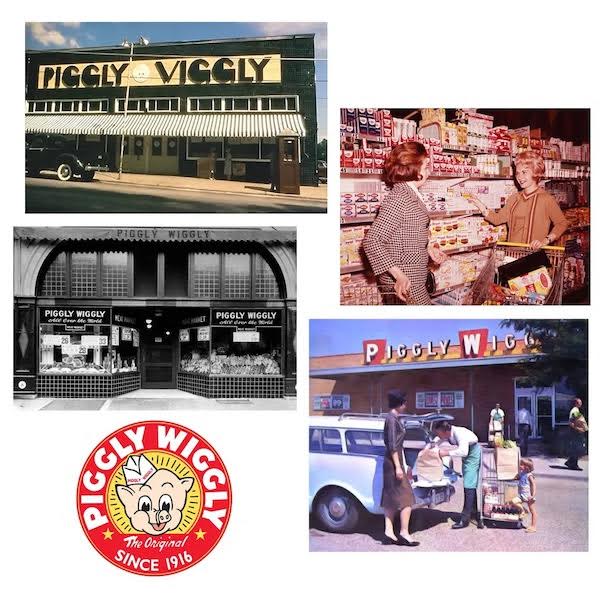It was on this day in 1916 that a store in Memphis, Tennessee, named “Piggly Wiggly” became the first true self-service grocery store in the US and the originator of various familiar supermarket concepts such as checkout stands, individual item price marking, and shopping carts.
Clarence Saunders, the founder of Piggly Wiggly, had the concept of the “self-serving store” patented in 1917. Saunders’ mother died when he was five. In 1891, his father moved the family to Montgomery County, Tennessee, where his father worked as a laborer and sharecropper. Saunders had only two years of formal education. At age 11, he worked in the sawmill and limestone kiln during the summer and at Burl Owens’ general store in Palmyra, Tennessee, during the holidays. At age 17, Saunders worked the Blossburg, AL, coke ovens and steel mill as a night watchman. At age 19, he started working in the wholesale grocery business for John Hurst and Joseph Boillin in Clarksville, Tennessee. Saunders married in 1903, and in 1904, they moved to Memphis, where Saunders worked for the wholesale grocers Shanks, Phillips & Co.
Fast forward about 12 years… Saunders opens his first official Piggly Wiggly located at 79 Jefferson Street in Memphis, Tennessee. Saunders had renovated a warehouse, removing old countertops, and replacing them with characteristic turnstiles at the entrance and exit, and cabinets arranged along a continuous path, which ended at a cashier stand complete with adding machine and cash register. The 1,125 sq ft store included a front lobby, the continuous-path middle salesroom, and rear stockroom. The store incorporated shopping baskets, self-service branded products, and checkouts at the front. Creating elaborate aisle displays, and rearranging the store to force customers to view all of the merchandise in a continuous path, were just some of the characteristics of the early Piggly Wiggly stores. The store stocked four times the variety of items normally found in an ordinary general store. A refrigerator separated two of the aisles, offering butter and cheese. Bins offered fruits and vegetables, while flour and other bulk goods were pre-packaged and placed near the end of the shopper’s journey through the aisles.
By 1921, there were 615 stores in 200 cities and 40 states. By 1923, Piggly Wiggly had grown into 1,267 stores, 667 owned by the company and the rest owned by franchisees. The company employed 250 people in Memphis. Stock in Piggly Wiggly Stores, Inc., paid a massive dividend of 11%.
In the early 1920s Saunders began construction of a pink marble mansion in Memphis. Then, in early 1923, a group of franchised outlets in New York failed. Merrill Lynch and other speculators on Wall Street attempted a bear raid on the price of Piggly Wiggly stock, gambling the price would fall. With a loan of $10 million from a number of Southern bankers, plus a bit of his own money, Saunders counteracted with a corner, buying a large amount of Piggly Wiggly stock in hopes of driving up the price. He flamboyantly declared his intent in newspaper ads. Saunders bought Piggly Wiggly stock until he had orders for 196,000 of the 200,000 outstanding shares. The firm’s share price went from a low of $39 in late 1922 to $124 by March 20, 1923. Pressured by the ‘bears’, the New York Stock Exchange declared a ‘corner’ existed and gave the ‘bears’ five days rather than 24 hours to deliver the stock Saunders had bought. The additional time meant “a flood of stock poured in from distant points and gave the shorts an opportunity to deliver.”
In the words of John Brooks, “…in mid-August, with the September 1st deadline for repayment of two and a half million dollars on his loan staring him in the face and with nothing like that amount of cash either on hand or in prospect, he resigned as president of Piggly Wiggly Stores, Inc., and turned over his assets-his stock in the company, his Pink Palace, and all the rest of his property to his creditors”… The Pink Palace mansion eventually became Memphis’ first museum in 1930.
Until the time of his death, Saunders was developing plans for another automatic store system called the “Foodelectric.” Saunders described his concept as follows: “The store operates so automatically that the customer can collect her groceries themselves, wrap them and act as her own cashier. It eliminates the checkout crush, cuts overhead expenses and enables a small staff to handle a tremendous volume… I will be able to handle +$2 million volume with only eight employees.” The concept store, which was to be located two blocks from the first Piggly Wiggly store in downtown Memphis, never opened. I would say Saunders was certainly a man ahead of his time and would be saying “I told you so…” if he were alive today.
I have to imagine the change or thought of shifting from a traditional “general store” to a modern-day grocery store concept was a huge deal, and took a giant leap of faith and a massive amount of creativity.









